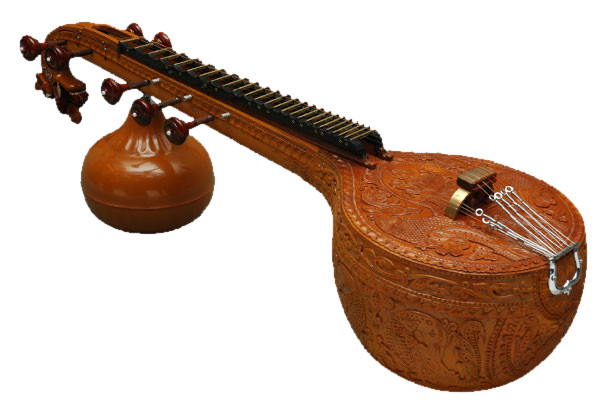Please wait ...

The veena , comprises a family of chordophone instruments of the Indian subcontinent. Ancient musical instruments evolved into many variations, such as lutes, zithers and arched harps. The many regional designs have different names such as the Rudra veena, the Saraswati veena, the Vichitra veena and others.
The North Indian design, that has been used in classical Hindustani music, is a stick zither. About 3.5 to 4 feet (1 to 1.2 meters) long to fit the measurements of the musician, it has a hollow body and two large resonating gourds under each end. It has four main strings which are melody type, and three auxiliary drone strings. To play, the musician plucks the melody strings downward with a plectrum worn on the first and second fingers, while the drone strings are strummed with the little finger of the playing hand. The musician stops the resonating strings, when so desired, with the fingers of the free hand. In modern times the veena has been generally replaced with the sitar in north Indian performances.
The South Indian veena design, used in classical Carnatic music, is a lute. It is a long-necked, pear-shaped lute, but instead of the lower gourd of the north Indian design it has a pear shaped wooden piece. It too, however, has 24 frets, four melody strings, three drone strings, and played quite similar. It remains an important and popular string instrument in classical Carnatic music.
As a fretted, plucked lute, the veena strings can produce pitches in full three octave range. The long hollow neck design of these Indian instruments allow portamento effects and legato ornaments found in Indian ragas. It has been a popular instrument in Indian classical music, and one revered in the Indian culture by its inclusion in the iconography of Saraswati, the Hindu goddess of arts and learning. These continue to be used, albeit with different designs, in Carnatic classical music and Hindustani classical music.
At a first glance, the difference between the North and South Indian design is the presence of two resonant gourds in North, while in South instead of the lower gourd there is a pear shaped wooden body attached. However, there are other differences, and many similarities. Modern designs use fiberglass or other materials instead of hollowed jackwood and gourds.The construction is personalized to the musician's body proportions so that she can hold and play it comfortably. It ranges from about 3.5 to 4 feet . The body is made of special wood and is hollow. Both designs have four melody strings, three drone strings and twenty four frets. The instrument's end is generally tastefully shaped such as a swan and the external surfaces colorfully decorated with traditional Indian designs.
The melody strings are tuned in c' g c G (the tonic, the fifth, the octave and the fourth), from which sarani (chanterelle) is frequently used. The drone strings are tuned in c" g' c'(the double octave, the tonic and the octave). The drones are typically used to create rhythmic tanams of Indian classical music and to express harmony with clapped tala of the piece.
The main string is called Nayaki Tar (????? ???), and in the Sarasvati veena it is on the onlooked's left side. The instrument is played with three fingers of the right (dominant) hand, struck inwards or outwards with a plectrum. The bola alphabets struck in the North Indian veena are da, ga, ra on the main strings, and many others by a combination of fingers and other strings. The veena settings and tuning may be fixed or adjusted by loosening the pegs, to perform Dhruva from fixed and Cala with loosened pegs such that the second string and first string coincide.
Reference Links: https://en.wikipedia.org/wiki/Veena